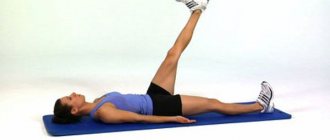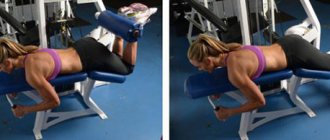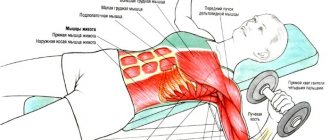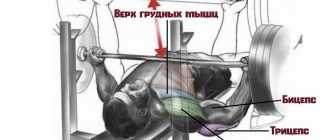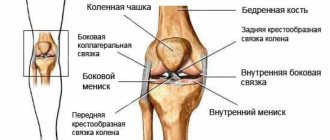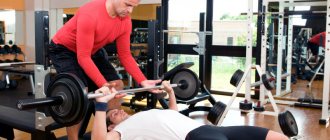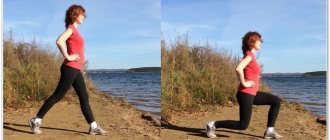Slender, toned and pumped legs are the dream of every person. Therefore, making them slim is quite difficult. But with maximum patience and diligence, performing the leg abduction exercise can achieve remarkable results.
The beauty of your feet requires care. Most people lead a sedentary lifestyle, wear tight clothes and high heels. These and many other habits lead to slower and impaired blood circulation, which can lead to stagnation in the blood vessels. This is how fat deposits, cellulite and venous networks arise.
For beauty, and most importantly, healthy legs, it is necessary to perform exercises aimed at improving blood flow, tightening the skin and toning the muscular system.
Main muscles involved during leg abduction
Active leg muscles during exercise
When we talk about “pumping up” the legs, we mean actively working out the calf muscles, rear biceps and thigh muscles (quadriceps).
Let's take a closer look:
- Soleus and gastrocnemius muscles - are involved in the movement of the foot and stabilize the body;
- The adductors are responsible for bringing the legs together;
- The quadriceps muscle extends the knee joint;
- Biceps (quadriceps antagonist) – flexes the knee joint;
- The gluteal muscles are the largest group. The hips are involved in the work (extension), the pelvis is moved to the side, and the torso is straightened.
Joel Seedman - sports physiologist, strength training expert
Engage your latissimus dorsi muscles and learn to pull the barbell towards you.
One of the most important components of the bench press is learning to activate your upper back and lats as you move the barbell down (toward your chest). Professional powerlifters have been promoting this principle for many years and believe that it is the “decisive factor” for achieving a powerful bench press.
Why is this so effective?
During the eccentric phase of the exercise (when the bar moves down to the chest), maximum simultaneous contraction of multidirectional muscle groups (agonist and antagonist muscles) occurs.
And they mutually inhibit each other. And during the concentric phase (when the bar moves upward from the chest), the antagonists (upper back and lats) relax, allowing the agonists (chest, shoulders and triceps) to contract with maximum force. This ultimately results in a super powerful release of force and energy as the bar moves upward from the chest.
What is the mechanism of action of this method?
Using the back muscles during the downward movement of the barbell creates a “catapult effect.” Essentially, the pressing muscles go into a state of readiness, similar to a compressed spring, where they are ready to fire as soon as the lats relax. This creates a powerful starting moment. But many people fail to engage their back muscles during the bench press. This nuance is quite difficult to understand.
One of the most effective exercises I have used with many athletes to teach this principle is the reverse bench press/reverse row .
Attach resistance bands (bands) to the top pins of a squat rack, then tie them to the bar and perform the bench press as you always do. This exercise is effective because it provides almost the same trajectory of movement of the bar and the work of the joints as with the bench press, only the antagonist muscles (the latissimus) work. You can feel this with the help of Australian pull-ups, but the trajectory of movement and mechanics are slightly different.
The reverse bench press directly teaches how to properly pull the barbell toward your chest during the eccentric phase. I have practiced it with many of my NFL (National Football League) athletes to increase their bench press performance. As an added bonus, a phenomenal neuromuscular connection is formed with the lats and upper back muscles , resulting in significant muscle hypertrophy and increased strength. But if you decide to use stiffer resistance bands, you will need to place some chains on top of your body or wear a weighted vest or belt to keep you on the bench.
Try combining this exercise - the reverse row with the classic bench press in the form of a superset (one after the other without rest) over several workouts. Not only will you have better feel and control of the barbell's movement, but you will also notice that you can handle significantly greater weights.
Working out the upper part of the pectoral muscles - barbell press on an incline bench.
Types of leg abduction
The result can be achieved through comprehensive training, using all muscle groups. Exercises should be performed with short pauses and at a high rhythm. Combine basic and isolated actions (working a specific muscle group).
It is recommended to perform exercises once every 7 days. This does not depend on the physical fitness of your legs. After exercise, the muscles need to recover. If after a few days you feel that your legs are rested, you can make the classes more intense and increase the number of repetitions.
Taking the leg back on the lower block (crossover)
The exercise is performed in two positions.
Leg abduction on the lower block
Standing leg abduction:
- the exercise machine should be in front of you, fix your foot in the bracelet;
- take your slightly bent leg back as high as possible;
- at the highest point, hold the position and take the original position;
- repeat the steps as many times as necessary.
Taking your legs back on all fours
Leg abduction on all fours:
- take a position facing the block and fix your foot;
- straighten your leg and stretch your foot;
- return to the original position without jerking and slowly;
- repeat the exercise as many times as necessary.
Recommendations:
Tool for creating a Brazilian butt
- do this exercise at the end of classes;
- number of repetitions – 15;
- give preference to quality rather than working weight;
- greater results will be achieved by tightening the buttocks.
Eirik Sandvik - powerlifting coach
Train your glute bridge.
When it comes to the bench press, most technical problems stem from a lack of full body tension—the exercise being performed without a stable base. This leads to pain in the shoulders, elbows and wrists... and even causes a training plateau (stagnation and lack of progress).
So if you want to bench press heavy weights, you need to generate powerful momentum FROM THE GROUND, through your feet, legs and torso, and then launch all that power from your upper back!
Using the bow and arrow analogy, imagine that everything that doesn't move (the legs and torso) is the bow, and the muscles in the upper body that do the pressing are the string. A tight and drawn bow will create the most momentum to launch the arrow. Compared to a slow “squeeze” of the barbell, the full body tension bench press literally catapults the barbell away from the chest.
What role does the gluteal bridge play in all of this?
It will teach you full body tension and force you to press from a solid, stable base . To do this exercise, rest your upper back on the edge of a regular bench. Squeeze your shoulder blades tightly together. Raise your hips and mentally try to press your feet into the ground. Play with different foot positions (forward, backward, and sideways) to find the most stable position.
You can hold the position of your body motionless for 20-30 seconds (similar to a glute bridge), or simultaneously perform a bench press with an empty bar.
This is a great exercise because the torso is in exactly the same position as the bench press and most people “learn” quite easily how to keep the body fully engaged. The only difference is that the buttocks do not touch the bench.
Jim Wendler's 5/3/1 program for increasing your personal best in the main lifts.
Pulling the leg back in the simulator
The exercise is considered easy, but very effective. The gluteal muscles are involved: large and middle.
Pulling the leg back in the simulator
The technique is not complicated. Your position is fixed, and stabilizer muscles do not take part in the process. The biggest advantage is that the quadriceps are not involved. You're building your butt, not your hips. For maximum core stability, press tightly against the machine.
- Set the required weight.
- When performing this exercise on buttock exercise machines, rest your other leg on a special platform. Both legs should be slightly bent at the knee joints.
- As you exhale, use a strong force in your leg muscles to push the platform back up.
- You should not straighten your leg too much; you need to move your leg back so that your thigh is almost parallel to the floor.
- We return the leg to its original position slowly.
- Then, after finishing the complex, we change the leg and do the complex for the other leg.
Legs are one of the most problematic areas for women. This is where fat deposits accumulate and excess fluid is retained.
Execution secrets:
- All actions are performed without jerking;
- the body is as motionless as possible;
- weight is not the main thing;
- secure your leg firmly;
- the range of movements is full, in the starting position we take a short pause;
- perform 3-4 sets of 10-15 repetitions on each leg.
Paul Carter - bodybuilding trainer
Eat more - gain weight.
I worked as a coach for many years and found that this is perhaps the best thing you can do to overcome stagnation in results. Despite all the talk about how to properly engage your triceps and back muscles, if your bench press progress has really stalled, it's likely your body weight has remained stagnant for a long time.
Don't believe me?
Spend the next two months not worrying about maintaining a sexy athletic figure and eat until you feel sick every day. And watch what happens to your bench press. The weight will increase rapidly.
However, what would I recommend in terms of technique?
I strongly encourage my guys to use a narrower grip because it tightens the upper back muscles, providing better protection and stability to the shoulder joints.
If you've used a wider grip in the past, be prepared for a blow to your ego at first because you probably won't be able to bench as much as you did before. But rest assured, the results will eventually return and continue to grow. And your shoulders and pectoral muscles will thank you for this!
Good to know: How to avoid rotator cuff problems.
Abduction of the leg in a crossover to the side
Leg abduction to the side on a crossover
The main thing is the technique of the exercise - not quickly and with a delay at the extreme point.
Technique:
- Secure your ankle with a bracelet, stand sideways to the equipment and support yourself with your free hand;
- exhaling, move your straight leg to the side as far as possible and fix the position for a few seconds;
- while inhaling, return to the original position;
- After completing the required number of abductions, change your leg.
Adviсe:
- For better muscle contraction, work overlapping;
- The main thing is technique;
- The working leg is as straight as possible;
- Keep your body straight;
- Full range of motion.
Leg abduction/extension while sitting in the exercise machine
Leg abduction/extension while sitting in the exercise machine
This exercise strengthens the inner thighs, improves their shape, tightens and improves posture and gait.
Technique:
- Select the required weight, adjust the width (you will feel a slight stretch), straighten and press your back against the machine. Take the starting position;
- As you exhale, pull your hips towards each other, hold the position for 2 counts;
- As you inhale, spread your hips without reaching the original position. This will ensure constant muscle tension.
Adviсe:
- the transition to the starting position occurs slowly;
- Do some stretching between sets;
- do not move your body and butt;
- do the complex at the end of your workout.
Leg abduction lying on your side
Leg abduction lying on your side
Leg abduction strengthens the minimus and medius muscles of the buttocks.
Technique:
- starting position - lying on your side, free hand under your head;
- the lower leg remains straight, and the working leg bends and rises as high as possible.
- muscles should be tense;
- slowly return to the original position.
Adviсe:
- press the body tightly to the floor;
- the hips, torso and head should be in the same plane;
- The standard number of repetitions per leg is 15.
Tom McCormick - online personal trainer
Increase the load using rubber bands and try to move your arms towards each other in the upper phase of the exercise.
Let's look at the load curve in muscle fibers.
When performing a bench press, the maximum load on the muscles occurs when the bar is at the bottom, and the minimum is at the highest point of the exercise. And your strength capabilities are exactly the opposite of this. You are weakest when the bar is down, and strongest when your arms are fully extended. As a result, with the barbell positioned at the top, the bench press causes minimal tension in the pectoral muscles. It is this fact that limits its effectiveness as an exercise for chest muscle growth. Mechanical tension is a key element of hypertrophy. Using additional resistance (rubber bands and chains) can solve this problem and make the load more even.
Even after adding bands, your pectoral muscles have the opportunity to relatively unload and "rest" a little when the bar is at the top point. When the arms are fully extended, all joints (wrists, elbows and shoulders) help support the weight. Therefore, very little load falls on the chest muscles.
What can be done?
Try to move your hands towards each other.
While your arms aren't actually moving, trying to move them creates friction. Friction is the force that resists sliding. In this way, you apply the load from a different angle, or in the language of physicists, you create a new line of force acting on the muscles. And it helps maintain a steady load throughout the entire range of motion. The added resistance of the rubber bands will make it more difficult for you to overcome the force of gravity. Plus, the frictional force against trying to move your arms together creates a high level of mechanical stress throughout the bench press. Well, it goes without saying: more tension means more muscles!
You might be interested in: 7 things no one will tell you until you start pumping.
Practical tips and advice
- You should exercise regularly with a gradual increase in load.
- To burn excess fat accumulation, you should perform exercises at a faster pace.
- Drink more fluids, but never sparkling water.
- Stretch your muscles between exercises.
- Restore and relax your muscles with creams and massages.
- Love yourself!
It is possible to make your legs slim. The main thing is proper nutrition and a suitable set of exercises.
By performing the above exercises consistently, and most importantly correctly, the first results will be noticeable very soon.
Do not neglect the rules of performing the exercise and safety during exercise.

